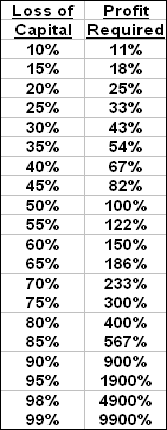As traders and investors, forgetting the past is not always a good thing. In order to learn and grow as successful investors we must learn from past mistakes and put rigour and rules in place to overcome the variables at play in the market – variables over which we have no control. The “largest loss trade” can result from these variables and can be catastrophic to a portfolio. Generally, investors who expose themselves to the largest loss trade are “buy and hold” type investors, investors with no exit strategy and / or investors breaking their own processes and rules.
Now that the market has provided some relief with a recent 55% rise from the lows in March of this year following the Global Financial Crisis crash, those who experienced “largest loss trades” need to sit back and objectively develop a plan on how to avoid a future re-occurrence. History tells us that steep falls in the market index will appear again and those that find themselves in falling stocks need to be prepared to cut their losses rather than employing the ‘hope and pray‘ method guided by the dysfunctional belief “that fundamentally sound stocks always recover”.
There are many examples of stocks that would supposedly recover such as Babcock and Brown, Allco, ABC Learning, MFS, Quintex and One-Tel in the Australian market and Enron, Lehman Bros and many others in the American markets. These stocks went to zero but many others such as Centro, many ASX listed property trusts, Freddie Mac and Fannie Mae fell by huge amounts and just hung on by the skin of their teeth and may take years to recover, if ever. I’m sure that readers will be able to identify their own “largest loss trades” in both high profile companies and little known minnows.
All of the above-mentioned stocks were part of their respective Indices at some stage, the ALL-ORDS or the S&P500. Remember that when stocks fall in market capitalisation they fall out of the index. Therefore their total fall from grace is not registered in the index but their complete fall, should you continue to hold them, will be registered in your portfolio for the rest of your life. This is known as “survivor bias” which is inherent in all stock market indices.
The table below shows the profit required to make back a loss. Total losses up to 30% are recoverable with solid trading processes and adherence to strict rules. When your portfolio losses or losses in individual trades get beyond 50% it becomes tougher to recover and losses beyond 70% become almost unrecoverable. I say almost because I believe that “anything can happen” in the markets. There will be the very odd occasion when a loss of greater than 70% does recover but I would hate to experience that level of drawdown in my active investing activities. The emotional turmoil and associated stress would be a nightmare. In any case, the opportunity loss is unnecessary compared to cutting out of the loss trade early on and re-investing the trading capital into another trade that has a high probability of rising as determined by researched criteria that indicate the high probability.
Avoiding the “largest loss trade” is far easier using technical analysis than using fundamental analysis because analysis of the price action of the stock is more timely than the analysis of fundamentals which are updated infrequently, relatively speaking.
Those using a mechanical approach to the market with no emotional attachment to either the shares in their portfolio or the need to be right, will simply follow the rules of the system and cut losing trades immediately that a sell signal is generated. This goes a long way towards avoiding the ‘largest loss trade’ or other similar outlier events. However, analysis is just a tool or a means to meet an objective. It is only a part of the skill-set required to be successful with investing. The other skills and requirements are continually presented and discussed in this weekly blog.
From the many hundreds of people that called our business during the GFC, I can say that private investors were not alone in holding these largest loss trades. Investment managers and fund managers were also caught up in stocks that went to zero – the only difference being that it was not their own money that they were losing. By sticking to the rules of a trading system with an edge, applying strict money management and position sizing rules, and taking ALL exit signals when they occur will go a long way to helping you avoid the ever present threat of the largest loss trade.



